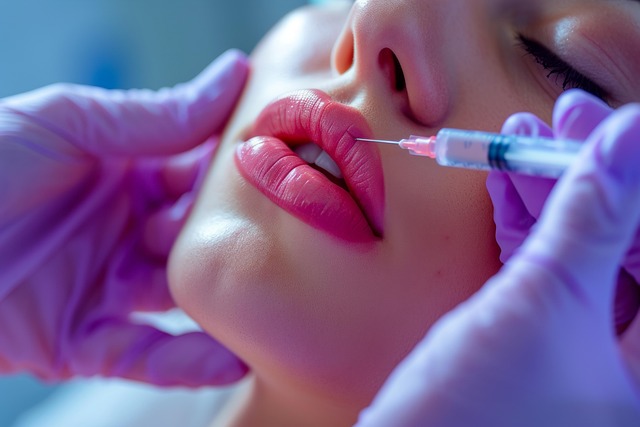Botox, derived from bacteria, is a non-invasive treatment for chronic migraines, targeting head and neck muscles that contribute to pain. It offers long-lasting relief without medication side effects. Additionally, Botox slims the jawline by relaxing muscle groups around it, addressing both dental discomfort caused by bruxism and aesthetic concerns. This multifaceted benefit makes Botox an appealing option for those seeking migraine relief and enhanced facial appearance. When considering treatment, consult qualified neurology specialists to ensure quality care and discuss desired medicinal and aesthetic outcomes.
“Discover the transformative power of Botox as a potent ally in migraine management. This comprehensive guide explores how this innovative treatment offers more than just relief from debilitating headaches—it also provides notable benefits for facial esthetics, including jawline slimming.
From understanding migraines and their impact to delving into the science behind Botox’s efficacy, this article navigates the world of Botox treatment, shedding light on its safety, potential side effects, and how to choose a qualified provider for optimal results.”
Understanding Migraines: Symptoms and Impact

Migraines are intense headaches that can significantly impact an individual’s daily life. They often present as a throbbing pain, which may be localized to one side of the head or spread across both sides. Migraine attacks are characterized by various symptoms, including nausea, sensitivity to light and sound (photophobia and phonophobia), and visual disturbances known as aura. The exact causes of migraines are not fully understood, but they are believed to involve complex interactions between genetic, environmental, and neurological factors.
The frequency and severity of migraine episodes vary from person to person. Some individuals experience rare, mild attacks, while others suffer from chronic, debilitating migraines that can occur several times a month. The impact of migraines extends beyond physical discomfort, as they can disrupt work, social activities, and overall quality of life. Many people with migraines seek effective relief options, leading them to explore treatments like Botox, particularly for jawline slimming, which has shown promising benefits in managing certain types of chronic headaches.
The Role of Botox in Treating Migraines

Botox, a protein derived from bacteria, has found its place in migraine treatment, offering a unique and effective approach to managing severe headaches. Beyond its well-known benefits for jawline slimming, Botox has been clinically proven to significantly reduce the frequency and intensity of migraines. The injection procedure involves targeting specific muscle groups in the head and neck, which are often overactive during migraine attacks. By relaxing these muscles, Botox can disrupt the pain signals that contribute to migraines, providing much-needed relief for patients.
This non-invasive therapy offers several advantages. It is a preventive measure that can be administered regularly to those suffering from chronic migraines. The procedure is relatively quick and minimally invasive, making it an appealing option for individuals seeking an alternative to traditional migraine medications. Moreover, Botox’s ability to reduce muscle tension in the face and head can lead to improved facial aesthetics, addressing concerns beyond just migraine relief.
Jawline Slimming: A Side Effect of Botox Treatment

Botox has gained recognition not only for its ability to alleviate migraines but also as a treatment for jawline slimming. This side effect is particularly appealing to individuals seeking non-surgical facial contouring. By relaxing certain muscles in the face and neck, Botox can reduce the appearance of a square or bulky jawline, creating a more defined and slender look.
The benefits of Botox for jawline slimming extend beyond aesthetic improvements. It can also alleviate tension and pain associated with clenching or grinding teeth (bruxism), which is often linked to a protruding or robust jawline. This dual advantage makes Botox an attractive option for those looking to enhance their facial appearance and address dental discomfort simultaneously.
How Botox Works for Migraine Relief

Botox, a protein derived from bacteria, has found its way into the realm of migraine relief, offering a unique and effective treatment option for those suffering from chronic headaches. Its mechanism of action involves targeting specific muscles in the head and neck that play a crucial role in migraine pain transmission. By temporarily paralyzing these muscles, Botox can significantly reduce the frequency and intensity of migraines. This non-invasive procedure is particularly appealing as it provides long-lasting relief without the need for ongoing medication, which often comes with side effects.
The benefits extend beyond migraine control; one of its lesser-known advantages is jawline slimming. When injected into specific muscle groups around the jawline and temples, Botox can relax these muscles, leading to a more defined and slender jawline appearance. This effect is particularly noticeable in individuals whose migraines are triggered by facial tension or clenching their jaws, as it helps alleviate that physical strain.
Benefits Beyond Migraine: Improved Facial Esthetics

Botox isn’t just a treatment for migraines; it offers several surprising benefits that extend beyond pain relief. One notable advantage is its potential to enhance facial esthetics, particularly when focused on the jawline area. By relaxing specific muscles responsible for jaw tension and clenching, Botox can contribute to slimming the jawline, providing a more defined and contoured look.
This aesthetic effect is especially appealing as it addresses common concerns related to facial balance and structure. The slimming of the jawline can make facial features appear more harmonious and can even mitigate the appearance of age-related sagging or jowls. Thus, for individuals seeking not only migraine relief but also improved facial aesthetics, Botox offers a multifaceted solution.
Safety and Efficacy Considerations for Botox in Migraine Management

When considering Botox as a migraine relief solution, it’s crucial to balance its potential benefits against safety considerations. Several clinical studies have demonstrated the efficacy of Botox in preventing migraines, with many patients reporting significant reductions in frequency and severity. However, not everyone is a suitable candidate for this treatment. Safety is paramount; Botox injections should only be administered by qualified healthcare professionals who can assess individual needs and risks.
One lesser-known benefit of Botox is its potential to reduce symptoms related to tension headaches and jawline slimming, which can indirectly alleviate migraine pain. While the primary focus of Botox in migraine management is preventing episodes, its multifaceted effects on muscle relaxation and facial aesthetics add another layer to its appeal. As with any medical procedure, ongoing research continues to refine understanding of both benefits and potential side effects, ensuring optimal outcomes for those seeking relief from chronic migraines.
Finding a Qualified Provider for Optimal Results

When considering migraine relief through Botox, finding a qualified and experienced provider is paramount to achieving optimal results. It’s crucial to seek professionals who specialize in neurologic treatments and have a proven track record with Botox injections. Look for practitioners certified by reputable medical organizations, as this ensures they adhere to strict standards and stay up-to-date with the latest research.
Additionally, consider the benefits of Botox not just for migraine treatment but also for jawline slimming. Some patients seek this non-invasive procedure for aesthetic reasons, knowing that relaxed jaw muscles can reduce the appearance of a squared jawline and improve overall facial balance. When choosing a provider, discuss these potential advantages to ensure they align with your goals and expectations.
